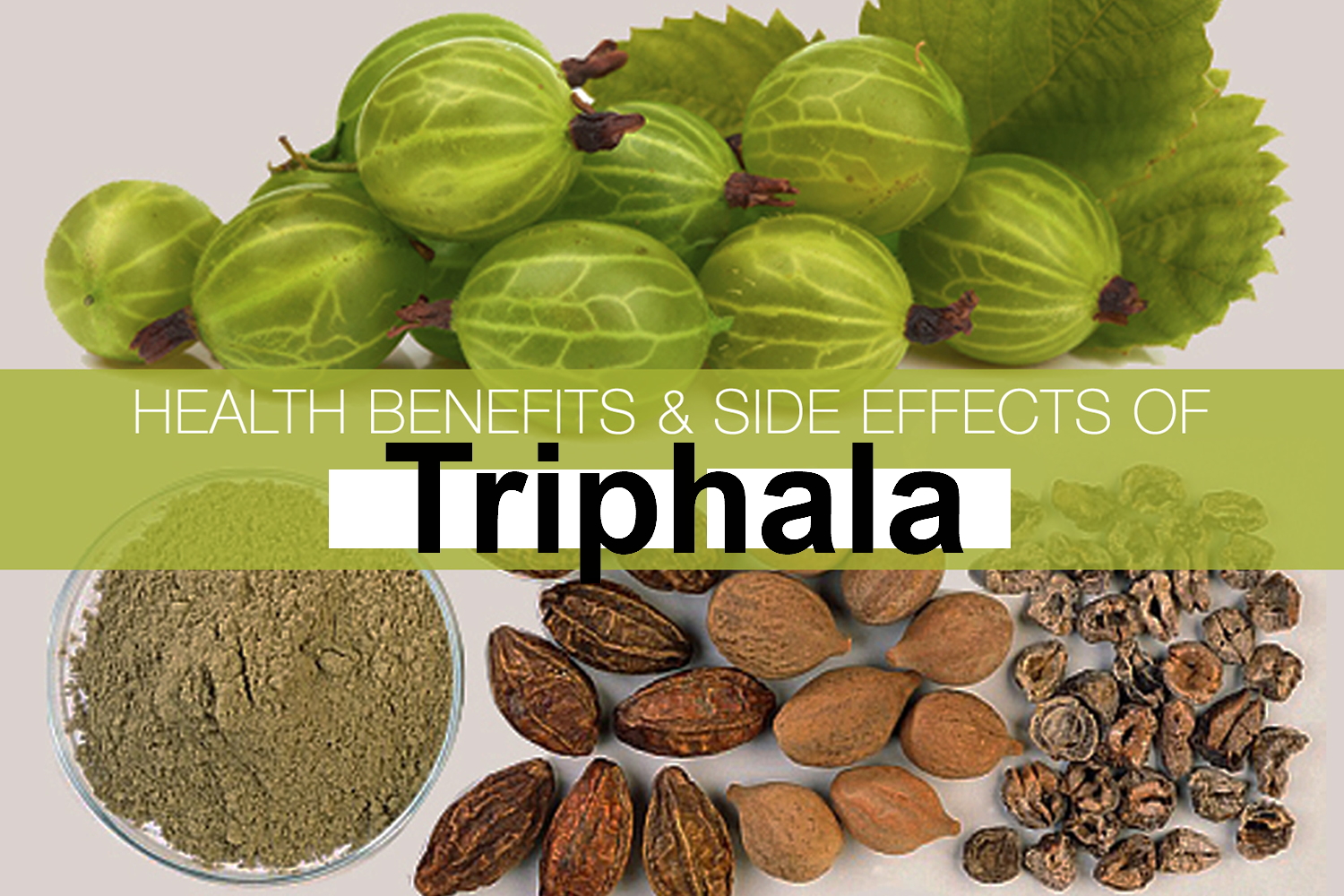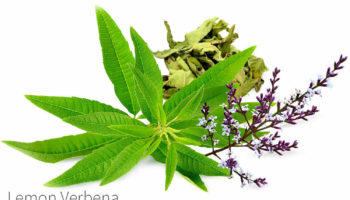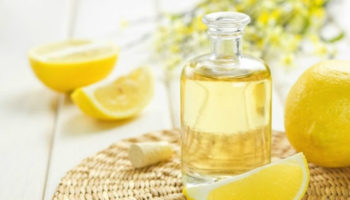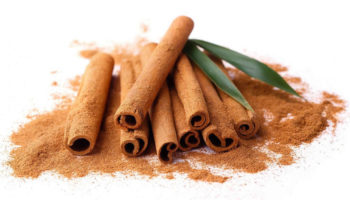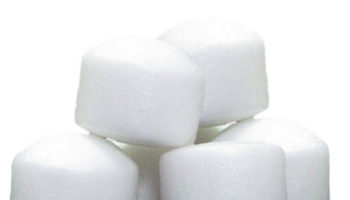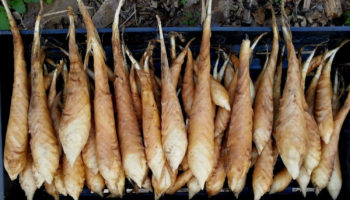Contents
- What is triphala ?
- Fruits of Triphala
- Main Chemical Constituents of Triphala
- Triphala benefits
- Triphala in gastrointestinal health
- Triphala in diabetes and for weight loss
- Stress-reducing potential of Triphala
- Triphala and cardiovascular health
- Antimicrobial potential of Triphala
- The Potential of Triphala in Oral Care
- Radioprotective effects of Triphala
- Anti-tumor activity of Triphala
- Antioxidant activity of Triphala and eye health
- Anti-inflammatory effects of Triphala
- Antiaging effects of Triphala
- Triphala and the gut microbiome
What is triphala ?
Triphala 1 is a herbal formulation composed of 3 fruits: Indian gooseberry Amalaki (Emblica officinalis), Bibhitaki (Terminalia belerica), and Haritaki (Terminalia chebula) in a 1:1:1 ratio. Triphala is mentioned throughout the ancient literature of Ayurvedic medicine as a tridoshic rasayana because it promotes longevity and rejuvenation in patients of all constitutions and ages 2. Triphala is classified as a tridoshic rasayana, meaning that the “energetics are appropriate for Vata, Pitta, and Kapha or all types of patients” 2. Charak, the great Indian Ayurvedic physician, describes rasayanas as having the qualities of supporting strength and immunity 3. Triphala has being traditionally used in India as therapeutic aid to regulate the process of digestion, mild laxative and antimicrobial properties in various ailments like prevention of dental caries/plaque formation, gingival health and periodontal diseases 4, 5, 6.
According to traditional Ayurvedic medicine, Triphala formulation is shown to have various medicinal properties which promote health, longevity of life when used in a proper manner 7. It is also shown to have anti-inflammatory, antioxidant, and antimicrobial properties (because of the gallic acid content), and is a known to be hepatoprotective in nature 8, 9, 10. Triphala is reported to correct constipation thus helping to improve digestion 7. Triphala can be ingested over a long period of time without any side effects 7. The phenolic and nonphenolic composition of triphala are active against both pathogenic and nonpathogenic bacterial strains 11, 12; when used as mouth wash, it effectively reduced the number of mutant streptococci in saliva 13.
Various studies have been done to evaluate the antifungal property of triphala 14.
Fruits of Triphala
Emblica officinalis (Amalaki)
Main chemical ingredient: Vitamin C, carotene, nicotinic acid, riboflavin, and tannins 15.
Amalaki is known by the botanical name Emblica officinalis and also known in Sanskrit as Dhatri (The nurse), which is a reference to its incredible healing properties. Amalaki can be taken individually in powder form, a decoction or as a confection. Amalaki fruit is known to be one of the best rasayanas in Ayurveda, with anti-oxidant and anti-aging properties. It has its beneficial role in cancer, diabetes, liver treatment, heart trouble, ulcer, anemia, and various other diseases. Similarly, it has application as immunomodulatory, anti-pyretic, analgesic, cytoprotective, anti-tussive, and gastroprotective agent. Additionally, it is useful in memory enhancing, ophthalmic disorders, and lowering cholesterol level. It is also helpful in neutralizing snake venom and as an anti-microbial agent against Escherichia coli, K. ozaenae, Klebsiella pneumoniae, Proteus mirabilis, Pseudomonas aeruginosa, S. paratyphi A, S. paratyphi B and Serratiamarcescens. The drug is not reported to have any side-effects even after prolonged use 16.
Figure 1. Embilica officinalis (Indian gooseberry)
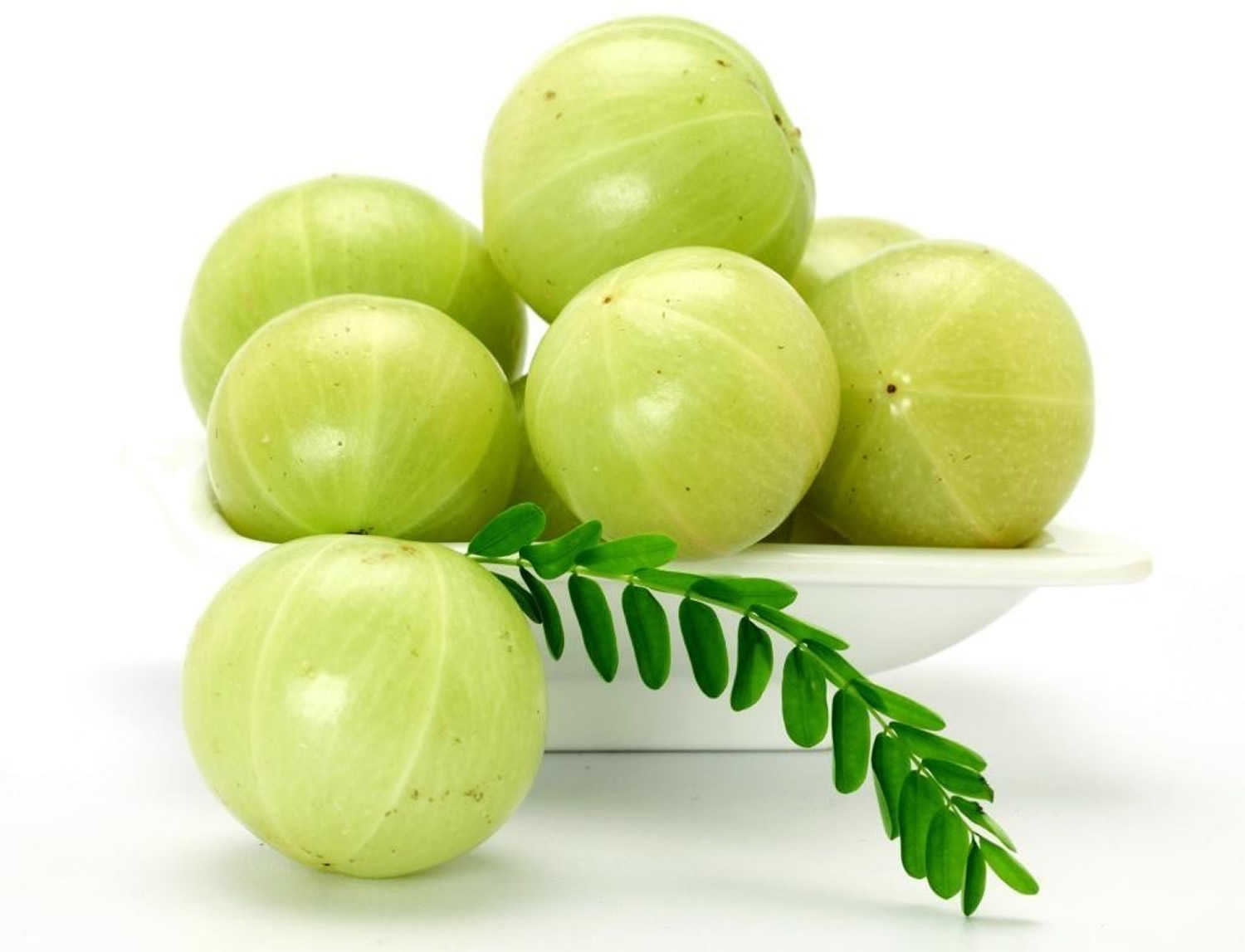
Terminalia chebula (Hiritaki or Black myrobalan)
Main chemical ingredient: Tannins, anthraquinones, and polyphenolic compounds 15.
Terminalia chebula is a plant species belonging to the genus Terminalia, family Combretaceae. The fruit of the tree has been used as traditional medicine for household remedy against various human ailments, since antiquity. Terminalia chebula has been extensively used in Ayurveda, Unani, and Homoeopathic medicine and has become a cynosure of modern medicine. Terminalia chebula is rich in tannin. The chief constituents of tannin are chebulic acid, chebulagic acid, corilagin, and gallic acid.
Terminalia chebula exhibited anti-bacterial activity against a number of Gram-positive and Gram-negative human pathogenic bacterial species. It also exhibits anti-fungal and anti-viral properties. It has also shown anti-mutagenic/anti-carcinogenic activity, antioxidant activity, adaptogenic and anti-anaphylactic activities, immunomodulatory activity, cytoprotective and radioprotective activity. It is also effective in hypolipidemia/hypercholesterolemia, improving gastro-intestinal motility with anti-spasmodic activity, diabetes, retinopathy, and wound healing 17.
Figure 2. Haritaki (Terminalia chebula)
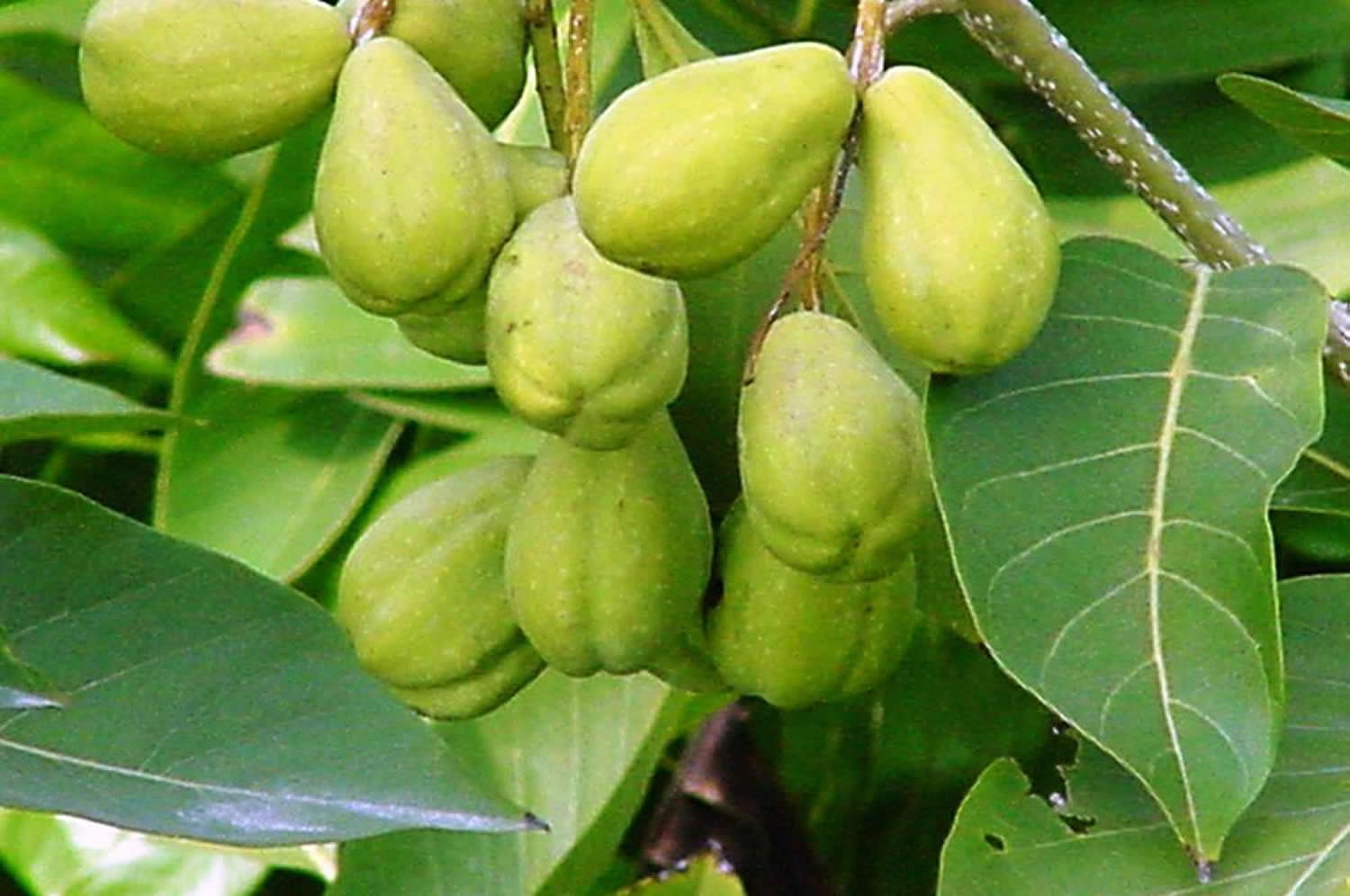
Terminalia belerica (Bibhitaki)
Main chemical ingredient: Gallic acid, tannic acid, and glycosides 15.
Terminalia bellerica Roxb. (Combretaceae), commonly known as “belleric myrobalan” and locally as “bahera,” is a large deciduous tree, found throughout central Asia and some other parts of the world. Its fruit is used in folk medicine to treat asthma, cancer, colic, diarrhea, dysuria, headache, hypertension, inflammations, and pain. The plant is reported to contain termilignan, thannilignan, anolignan B, gallic acid, ellagic acid, ί-sitosterol, arjungenin, belleric acid, bellericosidem, flavonoids, and tannins. T. belerica possesses antioxidant, anti-spasmodic, bronchodilatory, hypercholesterolemic, anti-bacterial, cardioprotective, hepatoprotective, hypoglycemic, and hypotensive properties 18.
Figure 3. Bibhitaki (Terminalia belerica)
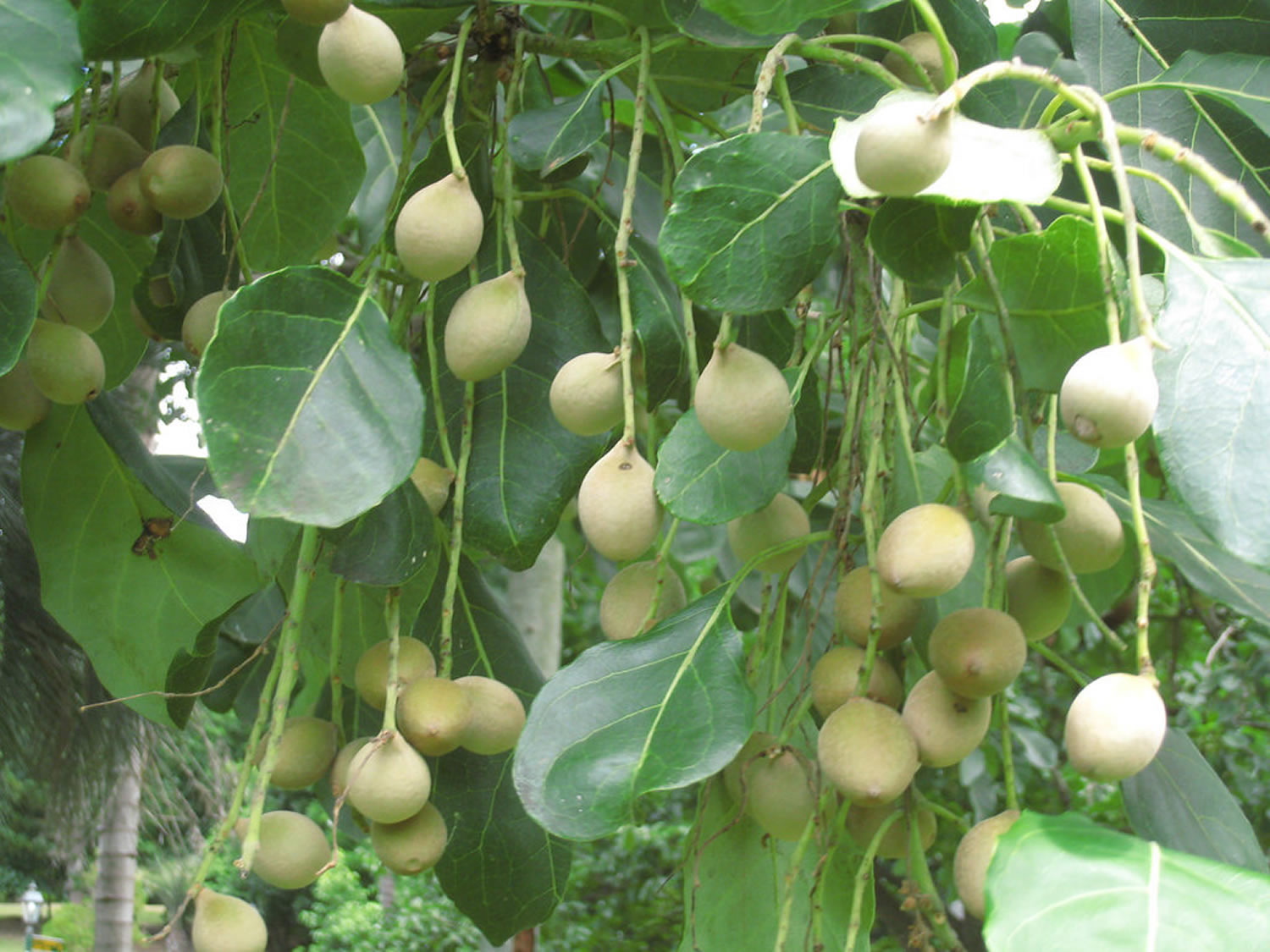
Main Chemical Constituents of Triphala
Tannins
Tannin is a general descriptive name for a group of polymeric phenolic substances capable of tanning leather or precipitating gelatin from solution, a property known as astringency. This group of compounds, especially green teas and red wines, has received a great deal of attention in recent years since they can cure or prevent a variety of ills. Many human physiological activities, such as stimulation of phagocytic cells, host-mediated tumor activity, and a wide range of anti-infective actions, have been assigned to tannins. One of their molecular actions is to complex with proteins through so-called non-specific forces such as hydrogen-bonding and hydrophobic effects, as well as by covalent bond formation. Thus, their mode of anti-microbial action may be related to their ability to inactivate microbial adhesins, enzymes, and cell envelope transport proteins 19.
Quinones
Quinones are aromatic rings with two ketone substitutions. They are ubiquitous in nature and are characteristically highly reactive. The individual redox potential of the particular quinine-hydroquinone pair is very important in many biological systems. Vitamin K is a complex naphthoquinone with anti-hemorrhagic activity. In addition to providing a source of stable free radicals, quinones are known to complex irreversibly with nucleophilic amino acids in proteins, often leading to inactivation of the protein and loss of function. For that reason, the potential range of quinone anti-microbial effects is great. Probable targets in the microbial cell are surface-exposed adhesins, cell wall polypeptides, and membrane-bound enzymes. Quinones may also render substrates unavailable to the microorganism 19.
Flavones, flavonoids, and flavonols
Flavones are phenolic structures containing one carbonyl group (as opposed to the two carbonyls in quinones). The addition of a 3-hydroxyl group yields a flavonol. Flavonoids are also hydroxylated phenolic substances, but occur as a C6-C3 unit linked to an aromatic ring. Since they are known to be synthesized by plants in response to microbial infection, it should not be surprising that they have been found in vitro to be effective anti-microbial substances against a wide array of microorganisms. Their activity is probably due to their ability to complex with extracellular and soluble proteins and to complex with bacterial cell walls. More lipophilic flavonoids may also disrupt microbial membranes. These compounds have been shown to inhibit Vibrio cholera O1, Shigella, Streptococcus mutansin vitro. Inhibition of isolated bacterial glucosyltransferases in S. mutans, and reduction of fissure caries by about 40% has also been demonstrated 19.
Gallic acid
Gallic acid is a common phyto-constituent present in all three herbs used in Triphala. It is reported to possess hepatoprotective and antioxidant activity. It also suppresses growth of cancer cells.
Vitamin C
Fruit juice of Emblica officinalis (Indian gooseberry Amalaki) contains the highest vitamin C (478.56 mg/100 mL) content. The fruit when blended with other fruits boosted their nutritional quality in terms of vitamin C content. Vitamin C in EO accounts for approximately 45-70% of the antioxidant activity 16. Evidences have been reported for the relation between vitamin C and periodontal disease. Significant gum bleeding can occur in vitamin C deficiency. Vitamin C along with bioflavonoid helps to speed up the healing process 16.
Triphala benefits
Ayurvedic physicians use Triphala for many ailments but most importantly to treat various gastrointestinal disorders, as digestive, mild laxative at normal doses, bowel tonic at low dose, purgative at high doses, carminative, expectorant, antispasmodic, and bronchodilator 2. Triphala is widely used to treat constipation, as an intestinal cleanser, as a gastrointestinal tract tonifier, to fasten peristalsis and to support both digestion and absorption of food. Triphala is also useful in maintaining serum cholesterol levels, to improve circulation, relax the bile duct and as a hepatoprotective agent 20. Daily use of Triphala may also promote proper digestion and absorption of food, reduce serum cholesterol levels, improve circulation, relax bile ducts, prevent immunosenescence, maintain homeostasis of the endocrine system, and increase production of red blood cells and hemoglobin 20.
The major active constituents of triphala are the tannins, gallic acid, ellagic acid, and chebulinic acid, which are potent antioxidants that may account, at least in part, for the observed immunomodulatory activity of the formula 21, 22, 23. Triphala also contains other bioactive compounds such as flavonoids (e.g., quercetin and luteolin), saponins, anthraquinones, amino acids, fatty acids, and various carbohydrates 22. In addition, Triphala-derived polyphenols such as chebulinic acid are also transformed by the human gut microbiota into bioactive metabolites, which have demonstrated potential in vitro to prevent oxidative damage 24.
Variable efficacy of herbal therapies
A number of factors, including variability in herbal source, processing, bioavailability, digestion, and absorption of herbal components, cause the true efficacy of herbs on human health to be highly variable. This variability is known to be at least partially due to inherent variation in the gut microbiota that act on the ingested components of herbal remedies and transform them into compounds with increased bioabsorption and bioactivity. These features have confounded the true efficacy of herbal remedies as it pertains to the maintenance of human health and/or the ability to reverse chronic disease states.
The increased popularity of herbal remedies such as Triphala has led to dramatic improvements in the processing of crude plant materials that serve to maximize the absorption of otherwise poorly absorbed plant components. Despite these improvements, these preparations still display pronounced variability in efficacy, which is likely related to the natural variation in composition of gut microbiota species that catalyze the biotransformation of herbal components. This response variability is not unique to herbs and, in fact, may be the case for virtually all health-promoting compounds ingested by humans (e.g., polyphenolic compounds derived from plants).
Triphala in gastrointestinal health
Triphala is perhaps most well known for its use in general gastrointestinal health. Animal studies have shown that both aqueous and alcohol-based extracts of Triphala prevent diarrhea 25. Triphala also induces enteroprotective effects, which are likely due, at least in part, to the high antioxidant content. In a rodent model, Triphala replenished depleted protein in the intestinal villi of the brush border as well as glutathione and phospholipid levels; the formula simultaneously decreased myeloperoxidase and xanthine oxidase levels in intestinal epithelium 26. In rats, Triphala exerted a gastroprotective effect on stress-induced ulcer 27. One human clinical trial that investigated the use of Triphala in patients with gastrointestinal disorders reported that treatment reduced constipation, mucous, abdominal pain, hyperacidity, and flatulence while improving the frequency, yield, and consistency of stool 28. Triphala also reduced colitis in a mouse model, and the treatment effect was attributed to antioxidant effects and high levels of flavonoids contained in Triphala 29.
Triphala in diabetes and for weight loss
Deregulation of eating behavior is common in industrialized countries. Studies have demonstrated the potential of Triphala as a therapeutic agent for weight loss and reduction of body fat. In an animal study, Triphala was administered for 10 weeks to diet-induced obese mice 30. Triphala treatment decreased the percentage of body fat, body weight, and energy intake. Triphala also decreased total cholesterol, triglycerides, and low-density lipoprotein cholesterol in the experimental group compared with the control group. In a 12-week, double-blind, randomized placebo-controlled trial, human subjects treated with Triphala lost ∼5 kg compared with the placebo control group 31. Mean fasting blood sugar and fasting serum insulin levels were also reduced in the treated compared with control subjects. Given the global obesity epidemic, more treatment options are necessary to reduce the associated healthcare burden.
Triphala exerts hypoglycemic effects. Patients with type 2 diabetes are likely to have high postprandial blood glucose levels, especially after consuming carbohydrates. Elevated blood glucose results from the breakdown of carbohydrates by the digestive enzymes, alpha-amylase and alpha-glucosidase, and the reduced ability of cells to take in glucose from the blood. Past studies report that Triphala may exert actions similar to diabetic pharmaceutical drugs by inhibiting digestive enzymes and may decrease absorption of glucose through inhibition of glycolytic enzymes, thereby reducing blood glucose levels. One study demonstrated the inhibitory potential of Triphala on pancreatic glycolytic enzymes, namely alpha-amylase and alpha-glucosidase, which break down larger polysaccharides into glucose molecules that enter the blood stream 31.
The role that Triphala plays in inhibiting starch digestion and absorption, thereby decreasing postprandial hyperglycemia, is similar to that of diabetes pharmaceutical drugs, such as miglitol and acarbose, which also target these glycolytic enzymes. In addition, Triphala decreased serum glucose levels in normal and alloxan-induced diabetic rats 32. A clinical study of noninsulin-dependent diabetes mellitus patients revealed that supplementation with 5 g of Triphala powder for 45 days significantly lowered blood glucose levels 33. Both fasting and postprandial blood glucose were reduced, which may be due to active ingredients such as sorbitol. Constituents in Triphala, including ellagitannins and gallotannins, also enhance both PPAR-alpha and -gamma signaling, which increase insulin responsiveness and glucose uptake without inducing adipogenesis 34. These polyphenols may also promote decreased blood glucose and insulin levels in diabetic patients.
Triphala may also protect diabetics and those predisposed to diabetes through inhibition of glycation enzymes. Elevated blood glucose can cause severe damage through the process of glycation, in which sugar molecules compromise protein molecules in the body, which may in turn lead to nerve damage or blindness. Due to the presence of tannins, Triphala extract was found to effectively inhibit protein glycation in vitro 35. Triphala may also prevent glycation through promotion of lower blood glucose levels. As diabetes is the most prevalent endocrine disease globally, increased access to complementary hypoglycemic therapies for integrative care is needed.
Stress-reducing potential of Triphala
Stress-induced disorders such as anxiety represent the leading causes of adult disability worldwide 36. Stress is a state of disharmony caused by perceived threat that is counteracted by an adaptive response to reestablish homeostasis and is associated with many chronic diseases. Animal studies have shown that Triphala protected against cold-induced stress and reversed stress-induced behavioral alterations and biochemical changes such as increased lipid peroxidation and corticosterone levels 37. Triphala also prevented noise-induced stress 38. In rats, Triphala prevented the noise-induced metabolic changes by mediating the antioxidant and cell-mediated immune response, and it was hypothesized that the biological mechanism is related to its antioxidant properties 39, 40. Modern humans experience high levels of stress, thus adaptogenic treatments are needed more extensively in clinical practice.
Triphala and cardiovascular health
Cardiovascular disease is a leading cause of mortality and morbidity worldwide, and hypercholesteremia is an important risk factor. Animal studies have reported the hypercholesteremic effects of Triphala. In one study, Triphala reduced the total cholesterol, low-density lipoprotein, very low-density lipoprotein, and free fatty acid levels in rats fed an atherogenic diet for 48 days 41. Another study in rats fed an atherogenic diet revealed that Haritaki, one of the herbs in Triphala, induced hypolipidemic effects in the herb-treated group. A reduction in total cholesterol, triglycerides, and total protein and elevation of high-density lipoprotein cholesterol were found in the herb-treated group compared with control group 42. Triphala is a powerful herb to address imbalances in the gastrointestinal tract and cardiovascular system and should be more widely studied in the context of these common diseases.
Antimicrobial potential of Triphala
Over administration of antibiotics has led to widespread drug resistance, thus it is becoming imperative that clinical researchers discover alternative and adjunctive antimicrobial agents with high efficacy. Both Triphala water decoctions (12%) and ethanol extracts (14%) have demonstrated antibacterial activity in vitro against bacterial isolates derived from patients infected with human immunodeficiency virus 43; the ethanol extracts were reported to have greater in vitro antimicrobial action against these species compared with the aqueous extracts, which may indicate lower solubility of the aromatic antibiotic compounds.
In addition, other studies report that these extracts also exert broad-spectrum antimicrobial action against antibiotic-resistant bacteria isolated from human subjects. The aqueous extracts (1:6) have demonstrated greater efficacy compared with the ethanol extracts (1:6) on pathogenic bacteria such as Escherichia coli and Staphylococcus aureus 44. In vitro, ethanol extracts of Triphala (100 mg/mL) components exhibited specific antimicrobial activity against multidrug-resistant clinical bacterial isolates 45. Thus, Triphala was reported to exert antibacterial effects on both gram-positive and gram-negative species in vitro and demonstrated potential for further investigation as a complementary or adjunct antimicrobial therapy.
In addition to antimicrobial effects against oral bacteria, Triphala has also demonstrated the potential to eradicate enteric pathogens in vitro. One study tested the effects of Triphala aqueous extract (200 mg/mL) against enteric bacterial pathogens in vitro and found that Triphala possesses strong antibacterial effects against Staphylococcus epidermidis and S. aureus and moderate effects against Proteus vulgaris, Pseudomonas aeruginosa, and Salmonella typhi 45. In addition to antibacterial effects, Triphala is also known to exhibit antifungal properties. Triphala exerts antifungal action against Asperigillus species and has been reported to inhibit the fungus by up to 37.96% in vitro. In particular, the aqueous extracts (1:1) of fresh fruits were found to be more effective than dry fruits 46. Thus, the formula represents a promising antimicrobial candidate in need of further study.
The Potential of Triphala in Oral Care
Triphala has been used traditionally in Ayurvedic medicine as an antimicrobial agent 47. Numerous controlled clinical trials have shown that Triphala significantly reduces the abundance of oral bacteria, dental plaque, and gingivitis in human subjects 48, 49. For example, Triphala is effective against Enterococcus faecalis, one of the most difficult to eliminate oral pathogens that are commonly isolated in chronic periodontitis. One study revealed that Triphala (5 mg/mL) in 10% dimethyl sulfoxide (DMSO) was equally or more effective at eliminating E. faecalis in vitro compared with NaOCl, a common irrigant used during root canals 50. Triphala was more effective than 0.5% and 1% NaOCl solution, but equally effective as 2.5% and 5% solutions.
In addition, another group reported that Triphala in 10% DMSO was more effective than 5.25% NaOCl solution against E. faecalis biofilms on ex vivo tooth substrate and suggested the extract as an alternative in the context of clinical root canal irrigation 51. A study using human primary teeth ex vivo revealed that Triphala suspended in 10% DMSO (1:3) exhibited significant antibacterial activity compared with control as well as higher antibacterial activity compared with 3% NaOCl 52. In vitro studies using Triphala ethanol extract have reported similar antimicrobial effects against E. faecalis compared with 2.5% NaOCl 53. Thus, Triphala may represent a potential therapy to eliminate E. faecalis as more side-effects and larger risk are associated with NaOCl solution treatment.
Dental caries, or cavities of the teeth, is a common infection associated with humans. Examining the use of Triphala as an oral antimicrobial agent, one study reported that Triphala dissolved in 10% DMSO exhibited a significant antibacterial effect ex vivo on extracted human mandibular premolars against Streptococcus mutans, which is one of the most prevalent oral pathogens responsible for dental cavities 54.
Human clinical trials using Triphala water decoction as a mouthwash report that it exerts comparable efficacy compared with chlorhexidine gluconate germicidal mouthwash in the prevention of dental caries.45,46 For example, a study in human subjects revealed that Triphala (6%) mouthwash promoted a significant reduction in oral streptococcus colonies. Oral streptococcus levels were measured after using a 6% Triphala mouthwash or 0.2% chlorhexidine mouthwash twice per day for 48 h and for 7 days; Streptococcus levels were reduced by 17% and 44%, respectively, in the Triphala-treated group 48. The researchers concluded that Triphala was as effective as 0.2% chlorhexidine mouthwash given that the results of the Triphala treatment were similar to the chlorhexidine-treated group. Another double-blind human clinical trial also reported significant reductions in oral streptococcus levels at 5 and 60 min after rinsing with 15 mL aqueous Triphala extract (10%) mouthwash 55.
In addition, a double-blind, randomized human clinical trial reported that Triphala (10%) mouthwash is effective against dental plaque and gingivitis in teenagers 56. The study reported Triphala as equally effective in antiplaque and antigingivitis activity compared with chlorhexidine. Moreover, a clinical study in children on the effects of Triphala (0.6%) mouthwash on dental plaque, gingival inflammation, and microbial growth also compared its efficacy with a commercially available chlorhexidine mouthwash. The results indicated that both the germicidal chlorhexidine (0.1%) and Triphala mouthwash were equally effective in reducing plaque and increasing gingival health after 9 months; however, Triphala was more effective than chlorhexidine in reducing microbial cell counts 5. A double-blind, randomized clinical trial in young adults also compared the efficacy of Triphala (0.6%) and chlorhexidine (0.12%) mouthwash for 21 days and reported a similar reduction in both plaque and gingival scores for both the Triphala- and chlorhexidine-treated groups 57. Triphala mouthwash treatment has also shown promise to reverse precancerous oral lesions associated with tobacco use in young adults 58.
In periodontal diseases, matrix metalloproteinases (MMPs) degrade extracellular matrix proteins in a spectrum of processes that include tissue remodeling such as the connective tissue destruction observed in periodontitis. Ex vivo Triphala studies using extracted gingival tissue have demonstrated a greater reduction of MMP-9 activity in patient-derived white blood cells treated with Triphala compared with patient-derived cells treated with the standard antibiotic drug 59. In treated tissue extracts, Triphala (1.5 mg/mL) reduced MMP-9 activity by 77%, while doxycycline (300 μg/mL) reduced MMP-9 activity by 59%. Thus, MMP inhibitors are important adjunctive therapies in periodontitis treatment and Triphala may represent a candidate to investigate in greater detail in this context. In addition, given the observed effectiveness of Triphala mouthwash compared with standard treatment, additional clinical trials should be performed to identify the potential for integration in dentistry.
Radioprotective effects of Triphala
Studies have concluded that Triphala may help prevent and reverse DNA damage and mutagenesis 60. The prevention of DNA damage is important given that it is often an initiating event in carcinogenesis. Research in animal models and in vitro has shown that Triphala is effective in prevention of mutagenesis induced by both chemical- and radiation-induced damage 61. An in vitro study found that Triphala eliminated reactive oxygen species in HeLa cells exposed to ionizing X-radiation or bleomycin, both of which generate DNA strand breaks through the generation of reactive oxygen species 62. In addition, gamma-radiation-induced plasmid DNA strand break was inhibited by Triphala in vitro. The rasayana formulation also inhibited radiation-induced lipid peroxidation in rat liver microsomes and demonstrated the ability to scavenge free radicals such as superoxide. Importantly, the high levels of phenolic compounds such as gallic acid were attributed to the free radical scavenging activity 61.
In animal models, Triphala intervention reduced radiation-induced mortality by 60% in mice fed Triphala for only 7 days before whole-body gamma-irradiation 63. Triphala reversed the increased xanthine oxidoreductase and decreased the superoxide dismutase activity that was observed post-irradiation. Treatment with Triphala also prevented DNA damage in murine white blood cells and spleen cells post-irradiation. Triphala may play a protective role against oxidation, even when administered after exposure.
In addition, other animal studies have reported significantly reduced acute intestinal damage after ionizing radiation exposure in groups fed Triphala (1 kg/g) for at least 5 days before radiation treatment 64. Moreover, studies have demonstrated that Triphala feeding before gamma-radiation exposure reduced radiation sickness and mortality in mice 65. Triphala was reported to scavenge hydroxyl, superoxide anion, and nitric oxide free radicals in a dose-dependent manner in vitro 65. Triphala aqueous extract feeding for 5 days before exposure was also reported as protective against gamma-radiation in mice at a dose of 10 mg/kg, which was 1/28 of the calculated LD50 dose 66. Thus, the antioxidant and free radical scavenging activities of Triphala were concluded to serve a role in its protective effect against ionizing radiation. Human clinical trials to further elucidate the mechanisms of radioprotective action and clinical utility are required.
Anti-tumor activity of Triphala
Triphala has been investigated as a potential antineoplastic agent.61 Numerous studies have been performed in this context and have shown that Triphala exerts an antineoplastic effect on many cancer cell lines, including those of the breast, prostate, colon, and pancreas 67. Data in cell lines show that Triphala has a differential modulatory effect on normal and cancer cell lines. Triphala induces cytotoxicity in cancer cells, which showed increases in intracellular reactive oxygen species, but not normal cells. Excised tumor tissue from Triphala-fed mice compared with controls suggested that apoptosis induction may have mediated reduced tumor growth 68.
Preclinical studies using in vitro and in vivo models report that Triphala inhibits cancer growth in both cell and in vivo models and the effects are mediated through the ERK and p53 pathways 69. In addition, methanol extract of Triphala suppressed proliferation and induced p53-independent apoptosis in human colon cancer stem cells 67. Triphala suppressed the expression of oncogenes, c-Myc and Cyclin D1, and thus Wnt pathway signaling to reduce proliferation and resistance to apoptosis. Triphala-induced apoptotic induction occurred through the intrinsic mitochondrial apoptotic signaling pathway. Moreover, one clinical trial reported that Triphala powder treatment in healthy humans increased cytotoxic T cells and NK cells in the experimental group compared with the control group 70. Thus, Triphala shows potential as an antineoplastic agent and thus should be systematically explored for potential as an adjunct therapy in the management of colon and other cancers.
Antioxidant activity of Triphala and eye health
Antioxidant effects of Triphala have the potential to help maintain eye health. Triphala is a rich source of vitamin C and flavonoids. One study used Triphala as a pretreatment in selenite-induced cataracts in mice. Triphala significantly restored glutathione levels in eye lenses. Triphala also increased the activities of antioxidant enzymes, such as superoxide dismutase, catalase, glutathione-S-transferase, and glutathione peroxidase, in the lenses of the experimental group when compared with the control group. While 100% of the mice in the control group developed cataracts, only 20% of the mice pretreated with Triphala developed cataracts. This effect may be linked to the antioxidant activity of Triphala 71.
Anti-inflammatory effects of Triphala
Chronic inflammation is deleterious and affects most major chronic health conditions. Triphala has shown promise as an anti-inflammatory agent. In one study, Triphala performed better or equivalent when compared with standard drug treatment for a variety of biochemical measurements of inflammation.19 In addition, Triphala significantly reduced inflammatory markers as well as bone and cartilage degradation in arthritic rats 72. In this study, Triphala extract was significantly more effective than the nonsteroidal anti-inflammatory drug, indomethacin, in ameliorating arthritic and inflammatory effects. Triphala reduced expression of inflammatory mediators such as IL-17, COX-2, and RANKL through inhibition of NF-κB activation. Another study found that Triphala increased antioxidant levels and decreased lipid peroxidation in the tissues of arthritic rats 73.
In lipopolysaccharide-stimulated macrophages, Triphala treatment suppressed production of inflammatory mediators (such as TNFα, IL-1β, IL-6, MCP-1, VEGF, NO, and PGE2), intracellular free radicals, inflammatory enzymes (such as iNOS and COX-2), and lysosomal enzyme release 74. Chebulagic acid, a constituent in Triphala, was found to inhibit COX and 5-LOX, which are both major enzymes involved in inflammation and carcinogenesis 75. Triphala also increased antioxidant activity in mice after induction of nephrotoxicity from bromobenzene. Triphala ameliorated nephrotoxic effects by upregulating antioxidant enzymes, superoxide dismutase, glutathione-S-transferase, and glutathione peroxidase. Lipid peroxidation and markers of kidney dysfunction were reduced in the Triphala-treated group compared with controls 76. The anti-inflammatory effects of Triphala should be investigated in greater detail.
Antiaging effects of Triphala
Triphala extract exerted highly protective antiaging effects on human skin cells in vitro. Triphala extract affects gene expression of human skin cells, stimulating collagen-1 and elastin-synthesizing genes and antioxidant genes responsible for the cellular antioxidant, SOD-2. Triphala extract was found to inhibit melanin production and hyperpigmentation due to the presence of protective phytochemicals. Furthermore, Triphala extract exhibited significant free radical scavenging activity on hydrogen peroxide-induced cell damage and senescence 77. These results demonstrate potential dermal antiaging effects of Triphala, such as increasing collagen and elastin, increasing cellular antioxidants, and decreasing hyperpigmentation.
Triphala and the gut microbiome
It is known that phytochemicals in Triphala such as quercetin and gallic acid promote the growth of Bifidobacteria and Lactobacillus species while inhibiting the growth of undesirable gut residents such as E. coli 78. In addition, the lactic acid bacteria possess enzymatic activity (e.g., tannase) to degrade plant tannins such as gallic acid contained in Triphala 79. For example, Triphala-derived polyphenols such as chebulinic acid are transformed by the human gut microbiota into metabolites such as urolithins, which have the potential to prevent oxidative damage 24. The authors speculate that the bioactivity of Triphala is elicited by the gut microbiome to generate a widened spectrum and abundance of anti-inflammatory compounds.
Triphala-induced benefits in both the elderly and persons of all ages may be enhanced by coadministration of specific probiotic species. Thus, probiotic formulations consisting of bacterial species capable of mediating the increased digestion, bioabsorption, and bioactivity of Triphala may increase and make more uniform the response and impact of Triphala treatment on human populations. Further studies are required to determine the full effect of Triphala on gut microbiota and the potential of specific probiotics to increase the efficacy of the herb.
- Sanskrit; tri = three and phala = fruits[↩]
- Peterson CT, Denniston K, Chopra D. Therapeutic Uses of Triphala in Ayurvedic Medicine. Journal of Alternative and Complementary Medicine. 2017;23(8):607-614. doi:10.1089/acm.2017.0083. https://www.ncbi.nlm.nih.gov/pmc/articles/PMC5567597/[↩][↩][↩]
- Agniveśa , Cakrapequation eq1equation eq2idatta , Śarmequation eq3 RM, Dash B. Agniveaś’s Caraka saequation eq4hita: Text with English Translation & Critical Exposition Based on Cakrapequation eq5equation eq6i Datta’s equation eq7yurveda dequation eq8pikequation eq9, 1st ed. Varanasi, India: Chowkhamba Sanskrit Series Office, 1976[↩]
- Singh RL, Gupta R, Dwivedi N. A review on anti-microbial activities of Triphala and its constituents. World J Pharm Pharm Sci. 2016;5:535–58.[↩]
- Bajaj N, Tandon S. The effect of Triphala and Chlorhexidine mouthwash on dental plaque, gingival inflammation, and microbial growth. International Journal of Ayurveda Research. 2011;2(1):29-36. doi:10.4103/0974-7788.83188. https://www.ncbi.nlm.nih.gov/pmc/articles/PMC3157106/[↩][↩]
- Role of triphala in the management of peridontal disease. Maurya DK, Mittal N, Sharma KR, Nath G. Anc Sci Life. 1997 Oct; 17(2):120-7. https://www.ncbi.nlm.nih.gov/pmc/articles/PMC3331093/pdf/ASL-17-120.pdf[↩]
- Duke JA, Bogenschutz-Godwin MJ, Ducelliar J, Duke PA. Handbook of Medicinal Herbs. 2nd ed. Boca Raton: CRC Press; 2002. pp. 70–1.[↩][↩][↩]
- Amala VE, Jeyaraj M. Determination of antibacterial, antifungal, bioactive constituents of Triphala by FT-IR and GC-MS analysis. Int J Pharm Pharm Sci. 2014;6:123–6.[↩]
- Gupta R, Gupta A, Singh RL. Hepatoprotective activities of Triphala and its constituents. Int J Pharma Res Rev. 2015;4:34–55.[↩]
- Gupta R, Singh RL, Singh P. Quantification of phytochemicals and evaluation of antioxidant potential of ethanolic leaf extract of Terminalia bellerica, Terminalia chebula and Emblica officinalis vis-a-vis Triphala. Int J Pharm Sci Rev Res. 2015;32:14–22.[↩]
- Sharma DK, Varshneya C, Mehta M. Total phenolic content and antioxidant activity of Triphala (an Ayurvedic formulation) and its constituents. Am J PharmTech Res. 2012;2:458–65.[↩]
- Ahmad I, Mehmood Z, Mohammad F. Screening of some Indian medicinal plants for their antimicrobial properties. J Ethnopharmacol. 1998;62:183–93. https://www.ncbi.nlm.nih.gov/pubmed/9741890[↩]
- Thomas B, Shetty SY, Shetty AV. Comparative evaluation of antimicrobial activity of Triphala and commercially available toothpaste: An in-vitro study. Int J Public Health Dent. 2011;2:8–12.[↩]
- Biju T, Sunaina S, Agrima V, Veena S. Comparative evaluation of antimicrobial activity of Triphala and commercially available toothpastes: An in-vitro study. Int J Public Health Dent. 2011;2:8–12.[↩]
- India: World Health Organization; 2010. WHO, 2010. Traditional Herbal Remedies for Primary Health Care.[↩][↩][↩]
- Khan KH. Roles of Emblica officinalis in medicine: A review. Bot Res Int. 2009;2:218–28.[↩][↩][↩]
- Chattopadhyay RR, Bhattacharyya SK. Terminalia chebula: An update. Pharmacogn Rev. 2007;1:151–6.[↩]
- Khan A, Gilani AH. Antisecretory and analgesic activities of Terminalia bellerica. Afr J Biotechnol. 2010;9:717–9.[↩]
- Cowan MM. Plant Products as Antimicrobial Agents. Clinical Microbiology Reviews. 1999;12(4):564-582. https://www.ncbi.nlm.nih.gov/pmc/articles/PMC88925/[↩][↩][↩]
- Scientific validation of the ethnomedicinal properties of the Ayurvedic drug Triphala: a review. Chin J Integr Med. 2012 Dec;18(12):946-54. doi: 10.1007/s11655-012-1299-x. Epub 2012 Dec 13. https://www.ncbi.nlm.nih.gov/pubmed/23239004/[↩][↩]
- Lu K, Chakroborty D, Sarkar C, et al. Triphala and Its Active Constituent Chebulinic Acid Are Natural Inhibitors of Vascular Endothelial Growth Factor-A Mediated Angiogenesis. Pal S, ed. PLoS ONE. 2012;7(8):e43934. doi:10.1371/journal.pone.0043934. https://www.ncbi.nlm.nih.gov/pmc/articles/PMC3427174/[↩]
- Belapurkar P, Goyal P, Tiwari-Barua P. Immunomodulatory Effects of Triphala and its Individual Constituents: A Review. Indian Journal of Pharmaceutical Sciences. 2014;76(6):467-475. https://www.ncbi.nlm.nih.gov/pmc/articles/PMC4293677/[↩][↩]
- Lee HS, et al. Antioxidant effects of aqueous extract of Terminalia chebula in vivo and in vitro. Biol Pharm Bull 2005;28:1639–1644. https://www.jstage.jst.go.jp/article/bpb/28/9/28_9_1639/_article[↩]
- Olennikov DN, Kashchenko NI, Chirikova NK. In Vitro Bioaccessibility, Human Gut Microbiota Metabolites and Hepatoprotective Potential of Chebulic Ellagitannins: A Case of Padma Hepaten® Formulation. Nutrients. 2015;7(10):8456-8477. doi:10.3390/nu7105406. https://www.ncbi.nlm.nih.gov/pmc/articles/PMC4632426/[↩][↩]
- Biradar YS, et al. Evaluation of anti-diarrhoeal property and acute toxicity of Triphala Mashi, an Ayurvedic formulation. J Herb Pharmacother 2007;7:203–212. https://www.ncbi.nlm.nih.gov/pubmed/18928142[↩]
- Nariya M, Shukla V, Jain S, Ravishankar B. Comparison of enteroprotective efficacy of triphala formulations (Indian herbal drug) on methotrexate-induced small intestinal damage in rats. Phytother Res 2009;23:1092–1098. https://www.ncbi.nlm.nih.gov/pubmed/19170156[↩]
- Nariya MB, Shukla VJ, Ravishankar B, Jain SM. Comparison of Gastroprotective Effects of Triphala Formulations on Stress-induced Ulcer in Rats. Indian Journal of Pharmaceutical Sciences. 2011;73(6):682-687. doi:10.4103/0250-474X.100252. https://www.ncbi.nlm.nih.gov/pmc/articles/PMC3480757/[↩]
- Pulok K, Mukherjee SR, Bhattacharyya S, et al. Clinical study of ‘Triphala’—A well known phytomedicine from India. Iran J Pharmacol Ther 2005;5:51–54.[↩]
- Rayudu V, Raju AB. Effect of Triphala on dextran sulphate sodium-induced colitis in rats. Ayu. 2014;35(3):333-338. doi:10.4103/0974-8520.153787. https://www.ncbi.nlm.nih.gov/pmc/articles/PMC4427837/[↩]
- Gurjar S, Pal A, Kapur S. Triphala and its constituents ameliorate visceral adiposity from a high-fat diet in mice with diet-induced obesity. Altern Ther Health Med 2012;18:38–45. https://www.ncbi.nlm.nih.gov/pubmed/23251942[↩]
- Kamali SH, Khalaj AR, Hasani-Ranjbar S, et al. Efficacy of “Itrifal Saghir”, a combination of three medicinal plants in the treatment of obesity; A randomized controlled trial. DARU Journal of Pharmaceutical Sciences. 2012;20(1):33. doi:10.1186/2008-2231-20-33. https://www.ncbi.nlm.nih.gov/pmc/articles/PMC3559014/[↩][↩]
- Patel D, Kumar R, Laloo D, Hemalatha S. Diabetes mellitus: An overview on its pharmacological aspects and reported medicinal plants having antidiabetic activity. Asian Pacific Journal of Tropical Biomedicine. 2012;2(5):411-420. doi:10.1016/S2221-1691(12)60067-7. https://www.ncbi.nlm.nih.gov/pmc/articles/PMC3609313/[↩]
- Rajan SS, Antony S. Hypoglycemic effect of triphala on selected non insulin dependent Diabetes mellitus subjects. Ancient Science of Life. 2008;27(3):45-49. https://www.ncbi.nlm.nih.gov/pmc/articles/PMC3330861/pdf/ASL-27-45.pdf[↩]
- Yang MH, Vasquez Y, Ali Z, et al. Constituents from Terminalia species increase PPARalpha and PPARgamma levels and stimulate glucose uptake without enhancing adipocyte differentiation. J Ethnopharmacol 2013;149:490–498. https://www.ncbi.nlm.nih.gov/pubmed/23850833[↩]
- Ganeshpurkar A, Jain S, Agarwal S. Experimental studies on glycolytic enzyme inhibitory and antiglycation potential of Triphala. Ayu. 2015;36(1):96-100. doi:10.4103/0974-8520.169000. https://www.ncbi.nlm.nih.gov/pmc/articles/PMC4687248/[↩]
- Whiteford HA, Ferrari AJ, Degenhardt L, Feigin V, Vos T. The Global Burden of Mental, Neurological and Substance Use Disorders: An Analysis from the Global Burden of Disease Study 2010. Forloni G, ed. PLoS ONE. 2015;10(2):e0116820. doi:10.1371/journal.pone.0116820. https://www.ncbi.nlm.nih.gov/pmc/articles/PMC4320057/[↩]
- Dhanalakshmi S, Devi RS, Srikumar R, et al. Protective effect of Triphala on cold stress-induced behavioral and biochemical abnormalities in rats. Yakugaku Zasshi 2007;127:1863–1867. https://www.jstage.jst.go.jp/article/yakushi/127/11/127_11_1863/_article[↩]
- Srikumar R, Parthasarathy NJ, Manikandan S, et al. Effect of Triphala on oxidative stress and on cell-mediated immune response against noise stress in rats. Mol Cell Biochem 2006;283:67–74. https://www.ncbi.nlm.nih.gov/pubmed/16444587[↩]
- Kumari N, et al. Effects of ionizing radiation on microbial decontamination, phenolic contents, and antioxidant properties of triphala. J Food Sci 2009;74: M109–M113. https://www.ncbi.nlm.nih.gov/pubmed/19397725[↩]
- Carlsen MH, Halvorsen BL, Holte K, et al. The total antioxidant content of more than 3100 foods, beverages, spices, herbs and supplements used worldwide. Nutrition Journal. 2010;9:3. doi:10.1186/1475-2891-9-3. https://www.ncbi.nlm.nih.gov/pmc/articles/PMC2841576/[↩]
- Saravanan S, Srikumar R, Manikandan S, et al. Hypolipidemic effect of triphala in experimentally induced hypercholesteremic rats. Yakugaku Zasshi 2007;127:385–388. https://www.jstage.jst.go.jp/article/yakushi/127/2/127_2_385/_article[↩]
- Maruthappan V, Shree KS. HYPOLIPIDEMIC ACTIVITY OF HARITAKI (TERMINALIA CHEBULA) IN ATHEROGENIC DIET INDUCED HYPERLIPIDEMIC RATS. Journal of Advanced Pharmaceutical Technology & Research. 2010;1(2):229-235. https://www.ncbi.nlm.nih.gov/pmc/articles/PMC3255428/[↩]
- Srikumar R, et al. Evaluation of the growth inhibitory activities of Triphala against common bacterial isolates from HIV infected patients. Phytother Res 2007;21:476–480. https://www.ncbi.nlm.nih.gov/pubmed/17273983[↩]
- Biradar YS, Jagatap S, Khandelwal KR, Singhania SS. Exploring of Antimicrobial Activity of Triphala Mashi—an Ayurvedic Formulation. Evidence-based Complementary and Alternative Medicine : eCAM. 2008;5(1):107-113. doi:10.1093/ecam/nem002. https://www.ncbi.nlm.nih.gov/pmc/articles/PMC2249739/[↩]
- Tambekar DH, Dahikar SB. Antibacterial activity of some Indian Ayurvedic preparations against enteric bacterial pathogens. Journal of Advanced Pharmaceutical Technology & Research. 2011;2(1):24-29. doi:10.4103/2231-4040.79801. https://www.ncbi.nlm.nih.gov/pmc/articles/PMC3217688/[↩][↩]
- Gautam AK, Avasthi S, Sharma A, Bhadauria R. Antifungal potential of triphala churna ingredients against Aspergillus species associated with them during storage. Pak J Biol Sci 2012;15:244–249. https://www.ncbi.nlm.nih.gov/pubmed/24199459[↩]
- Prakash S, Shelke AU. Role of Triphala in dentistry. Journal of Indian Society of Periodontology. 2014;18(2):132-135. doi:10.4103/0972-124X.131299. https://www.ncbi.nlm.nih.gov/pmc/articles/PMC4033874/[↩]
- Srinagesh J, Krishnappa P, Somanna SN. Antibacterial efficacy of triphala against oral streptococci: An in vivo study. Indian J Dent Res 2012;23:696. https://www.ncbi.nlm.nih.gov/pubmed/23422630[↩][↩]
- Naiktari RS, Gaonkar P, Gurav AN, Khiste SV. A randomized clinical trial to evaluate and compare the efficacy of triphala mouthwash with 0.2% chlorhexidine in hospitalized patients with periodontal diseases. Journal of Periodontal & Implant Science. 2014;44(3):134-140. doi:10.5051/jpis.2014.44.3.134. https://www.ncbi.nlm.nih.gov/pmc/articles/PMC4050230/[↩]
- Shakouie S, Eskandarinezhad M, Gasemi N, Milani AS, Samiei M, Golizadeh S. An In Vitro Comparison of the Antibacterial Efficacy of Triphala with Different Concentrations of Sodium Hypochlorite. Iranian Endodontic Journal. 2014;9(4):287-289. https://www.ncbi.nlm.nih.gov/pmc/articles/PMC4224768/[↩]
- Prabhakar J, et al. Evaluation of antimicrobial efficacy of herbal alternatives (Triphala and green tea polyphenols), MTAD, and 5% sodium hypochlorite against Enterococcus faecalis biofilm formed on tooth substrate: An in vitro study. J Endod 2010;36:83–86. https://www.ncbi.nlm.nih.gov/pubmed/20003940[↩]
- Thomas S, Asokan S, John B, Priya G, Kumar S. Comparison of Antimicrobial Efficacy of Diode Laser, Triphala, and Sodium Hypochlorite in Primary Root Canals: A Randomized Controlled Trial. International Journal of Clinical Pediatric Dentistry. 2017;10(1):14-17. doi:10.5005/jp-journals-10005-1399. https://www.ncbi.nlm.nih.gov/pmc/articles/PMC5360796/[↩]
- Saxena D, Saha SG, Saha MK, et al. An in vitro evaluation of antimicrobial activity of five herbal extracts and comparison of their activity with 2.5% sodium hypochlorite against Enterococcus faecalis. Indian J Dent Res 2015;26:524–527. https://www.ncbi.nlm.nih.gov/pubmed/26672425[↩]
- Prabhakar J, Balagopal S, Priya MS, et al. Evaluation of antimicrobial efficacy of Triphala (an Indian Ayurvedic herbal formulation) and 0.2% chlorhexidine against Streptococcus mutans biofilm formed on tooth substrate: An in vitro study. Indian J Dent Res 2014;25:475–479. https://www.ncbi.nlm.nih.gov/pubmed/25307912[↩]
- Saxena S, Lakshminarayan N, Gudli S, Kumar M. Anti Bacterial Efficacy of Terminalia Chebula, Terminalia Bellirica, Embilica Officinalis and Triphala on Salivary Streptococcus Mutans Count – A Linear Randomized Cross Over Trial. Journal of Clinical and Diagnostic Research : JCDR. 2017;11(2):ZC47-ZC51. doi:10.7860/JCDR/2017/23558.9355. https://www.ncbi.nlm.nih.gov/pmc/articles/PMC5376913/[↩]
- Chainani SH, et al. Antiplaque and antigingivitis efficacy of triphala and chlorhexidine mouthrinse among schoolchildren—A cross-over, double-blind, randomised controlled trial. Oral Health Prev Dent 2014;12:209–217. https://www.ncbi.nlm.nih.gov/pubmed/25197734[↩]
- Baratakke SU, et al. Efficacy of triphala extract and chlorhexidine mouth rinse against plaque accumulation and gingival inflammation among female undergraduates: A randomized controlled trial. Indian J Dent Res 2017;28:49–54. https://www.ncbi.nlm.nih.gov/pubmed/28393817[↩]
- Deshpande A, Tandon S, Deshpande N. Low resource screening method of pre-cancerous lesions and its reversal by Triphala in teen-age Indian population. Ayu. 2014;35(2):160-167. doi:10.4103/0974-8520.146233. https://www.ncbi.nlm.nih.gov/pmc/articles/PMC4279322/[↩]
- Abraham S, Kumar MS, Sehgal PK, et al. Evaluation of the inhibitory effect of triphala on PMN-type matrix metalloproteinase (MMP-9). J Periodontol 2005;76:497–502. https://www.ncbi.nlm.nih.gov/pubmed/15857087[↩]
- Baliga MS, Meera S, Vaishnav LK, et al. Rasayana drugs from the Ayurvedic system of medicine as possible radioprotective agents in cancer treatment. Integr Cancer Ther 2013;12:455–463. https://www.ncbi.nlm.nih.gov/pubmed/23737641[↩]
- Naik GH, et al. In vitro antioxidant studies and free radical reactions of triphala, an ayurvedic formulation and its constituents. Phytother Res 2005;19:582–586. https://www.ncbi.nlm.nih.gov/pubmed/16161061[↩][↩]
- Takauji Y, et al. Triphala, a formulation of traditional Ayurvedic medicine, shows protective effect against X-radiation in HeLa cells. J Biosci 2016;41:569–575. https://www.ncbi.nlm.nih.gov/pubmed/27966480[↩]
- Sandhya T, et al. Protection against radiation oxidative damage in mice by Triphala. Mutat Res 2006;609:17–25. https://www.ncbi.nlm.nih.gov/pubmed/16860592[↩]
- Yoon WS, et al. Protective effect of triphala on radiation induced acute intestinal mucosal damage in Sprague Dawley rats. Indian J Exp Biol 2012;50:195–200. https://www.ncbi.nlm.nih.gov/pubmed/22439434[↩]
- Jagetia GC, Malagi KJ, Baliga MS, et al. Triphala, an ayurvedic rasayana drug, protects mice against radiation-induced lethality by free-radical scavenging. J Altern Complement Med 2004;10:971–978. https://www.ncbi.nlm.nih.gov/pubmed/15673991[↩][↩]
- Jagetia GC, Baliga MS, Malagi KJ, Sethukumar Kamath M. The evaluation of the radioprotective effect of Triphala (an ayurvedic rejuvenating drug) in the mice exposed to gamma-radiation. Phytomedicine 2002;9:99–108. https://www.ncbi.nlm.nih.gov/pubmed/11995956[↩]
- Vadde R, Radhakrishnan S, Reddivari L, Vanamala JKP. Triphala Extract Suppresses Proliferation and Induces Apoptosis in Human Colon Cancer Stem Cells via Suppressing c-Myc/Cyclin D1 and Elevation of Bax/Bcl-2 Ratio. BioMed Research International. 2015;2015:649263. doi:10.1155/2015/649263. https://www.ncbi.nlm.nih.gov/pmc/articles/PMC4488090/[↩][↩]
- Sandhya T, Lathika KM, Pandey BN, Mishra KP. Potential of traditional ayurvedic formulation, Triphala, as a novel anticancer drug. Cancer Lett 2006;231:206–214. https://www.ncbi.nlm.nih.gov/pubmed/15899544[↩]
- Shi Y, Sahu RP, Srivastava SK. Triphala inhibits both in vitro and in vivo xenograft growth of pancreatic tumor cells by inducing apoptosis. BMC Cancer. 2008;8:294. doi:10.1186/1471-2407-8-294. https://www.ncbi.nlm.nih.gov/pmc/articles/PMC2576337/[↩]
- Phetkate P, Kummalue T, U-pratya Y, Kietinun S. Significant Increase in Cytotoxic T Lymphocytes and Natural Killer Cells by Triphala: A Clinical Phase I Study. Evidence-based Complementary and Alternative Medicine : eCAM. 2012;2012:239856. doi:10.1155/2012/239856. https://www.ncbi.nlm.nih.gov/pmc/articles/PMC3519011/[↩]
- Gupta SK, Kalaiselvan V, Srivastava S, Agrawal SS, Saxena R. Evaluation of anticataract potential of Triphala in selenite-induced cataract: In vitro and in vivo studies. Journal of Ayurveda and Integrative Medicine. 2010;1(4):280-286. doi:10.4103/0975-9476.74425. https://www.ncbi.nlm.nih.gov/pmc/articles/PMC3117320/[↩]
- Kalaiselvan S, Rasool M. Triphala exhibits anti-arthritic effect by ameliorating bone and cartilage degradation in adjuvant-induced arthritic rats. Immunol Invest 2015;44:411–426. https://www.ncbi.nlm.nih.gov/pubmed/25942351[↩]
- Kalaiselvan S, Rasool MK. The anti-inflammatory effect of triphala in arthritic-induced rats. Pharm Biol 2015;53:51–60. https://www.ncbi.nlm.nih.gov/pubmed/25289531[↩]
- Kalaiselvan S, Rasool MK. Triphala herbal extract suppresses inflammatory responses in LPS-stimulated RAW 264.7 macrophages and adjuvant-induced arthritic rats via inhibition of NF-kappaB pathway. J Immunotoxicol 2016;13:509–525. https://www.ncbi.nlm.nih.gov/pubmed/27438966[↩]
- Reddy DB, et al. Chebulagic acid, a COX-LOX dual inhibitor isolated from the fruits of Terminalia chebula Retz., induces apoptosis in COLO-205 cell line. J Ethnopharmacol 2009;124:506–512. https://www.ncbi.nlm.nih.gov/pubmed/19481594[↩]
- Baskaran UL, Martin SJ, Mahaboobkhan R, Prince SE. Protective role of Triphala, an Indian traditional herbal formulation, against the nephrotoxic effects of bromobenzene in Wistar albino rats. J Integr Med 2015;13:115–121. https://www.ncbi.nlm.nih.gov/pubmed/25797642[↩]
- Varma SR, Sivaprakasam TO, Mishra A, et al. Protective Effects of Triphala on Dermal Fibroblasts and Human Keratinocytes. Slominski AT, ed. PLoS ONE. 2016;11(1):e0145921. doi:10.1371/journal.pone.0145921. https://www.ncbi.nlm.nih.gov/pmc/articles/PMC4711708/[↩]
- Boto-Ordonez M, et al. High levels of Bifidobacteria are associated with increased levels of anthocyanin microbial metabolites: A randomized clinical trial. Food Funct 2014;5:1932–1938. https://www.ncbi.nlm.nih.gov/pubmed/24958563[↩]
- Jiménez N, Curiel JA, Reverón I, de las Rivas B, Muñoz R. Uncovering the Lactobacillus plantarum WCFS1 Gallate Decarboxylase Involved in Tannin Degradation. Applied and Environmental Microbiology. 2013;79(14):4253-4263. doi:10.1128/AEM.00840-13. https://www.ncbi.nlm.nih.gov/pmc/articles/PMC3697502/[↩]
